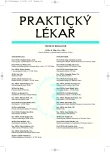Endoscopic cytoscopy – a new method for investigation of the gastrointestinal tract
Authors:
Z. Beneš
Authors‘ workplace:
Přednosta: MUDr. Zdeněk Beneš, CSc.
; II. interní klinika, Fakultní Thomayerova nemocnice, Praha
Published in:
Prakt. Lék. 2008; 88(3): 172-174
Category:
Diagnostis
Overview
Endoscopic cytoscopy is one of the new methods that aims to offer a very detailed image of the gastrointestinal mucosa. This method enables magnification of the mucosa under investigation up to 1 200x and it is the only endoscopic method that provides a very detailed chromatic picture of the morphological structure of the mucosa, its cells, including nuclei, nucleoli, etc., in vivo. The investigation takes place during routine endoscopy and enables detection of possible inflammatory, preneoplastic and malignant changes of the gastrointestinal mucosa. Very good cooperation with a pathologist is very important. The method is suitable for investigation of the stomach, large bowel and particularly the oesophagus. Endocytoscopy is particularly applicable in patients where a biopsy is associated with an increased risk of bleeding.
Key words:
endoscopy, endoscopic cytoscopy, morphologic changes of mucosa
Sources
1. Fuji, T., Iishi H., Tatsuta, M. et al. Effectiveness of premedication with pronase for improving visibility during gastroendoscopy: a randomized controlled trial. Gastrointest. Endosc. 1998, 47, p. 382-387.
2. Chiu, P.W.Y., Inoue, H., Satodate, H. et al. Validation of the quality of histological images obtained of fresh and formalin-fixed speciemens of esophageal and gastric mucosa by laser-scanning confocal microscopy. Endoscopy 2006, 38 (3), p. 236-240.
3. Inoue, H., Kudo, S., Shiokawa A. Novel endoscopic imaging techniques toward in vivo observation of living cancer cells in the gastrointestinal tract. Dig. Dis. 2004, 22, p. 334-337.
4. Inoue, H., Sasajima, K., Kaga, M. et al. Endoscopic in vivo evaluation of tissue atypia in the esophagus using a newly designed intergrated endocytoscope: a pilot trial. Endoscopy 2006, 38 (9), p. 891-895.
5. Kakeji, Y., Yamaguchi, S., Yoshida D. et al. Development and assessment of morfologic criteria for diagnosing gastric cancer using confocal endomicroscopy: an ex vivo and in vivo study. Endoscopy 2006, 38 (9), p. 886-890.
6. Kumagai, Y., Monma, K., Kawada, K. Magnifying chromoendoscopy of the esophagus: In vivo pathological diagnosis using an endocytoscopy system. Endoscopy 2004, 36 (7), p. 590-594.
7. Kumagai, Y., Toi, M., Inoue, H. Dynamism of tumour fasculature in the early phase of cancer progression: outcomes from oesophage cancer research. Lancet Oncol 2002, 3, p. 604–610.
8. Saito, N., Sato, F., Oda, A. et al. Removal mucus for ultrastructural observation of the surface of human epithelium using pronase. Helicobacter 2002, 7, 2, p. 112-115.
9. Sakashita, M., Inoue, H., Kashida, H. et al. Virtual histology of colorectal lesions using laser-scanning confocal microscopy. Endoscopy 2003, 35 (12), p. 1033-1038.
10. Sano, Y., Saito, Y., I Fu K. et al. Efficacy of magnifying chromoendoscopy for the differential diagnosis of colorectal lesions. Digestive Endoscopy 2005, 17, p. 105-116.
11. Sasajima, K., Kudo, S., Inoue, H. et al. Real-time in vivo virtual histology of colorectal lesions when using the endocytoscopy systém. Gastrointest. Endosc. 2006, 63 (7), p. 1010-7.
Labels
General practitioner for children and adolescents General practitioner for adultsArticle was published in
General Practitioner

2008 Issue 3
- Memantine Eases Daily Life for Patients and Caregivers
- Metamizole vs. Tramadol in Postoperative Analgesia
- Metamizole at a Glance and in Practice – Effective Non-Opioid Analgesic for All Ages
- Memantine in Dementia Therapy – Current Findings and Possible Future Applications
- What Effect Can Be Expected from Limosilactobacillus reuteri in Mucositis and Peri-Implantitis?
Most read in this issue
- Genitourinary tuberculosis – current state
- The convergence between neurological and psychogenic etiopathogenesis and the possibilities of psychotherapy.
- The importance of oral hygiene in the prevention of plaque induced oral cavity diseases
- Combined chelation treatment in patients with myelodysplastic syndrome and hereditary hemochromatosis – a case study
